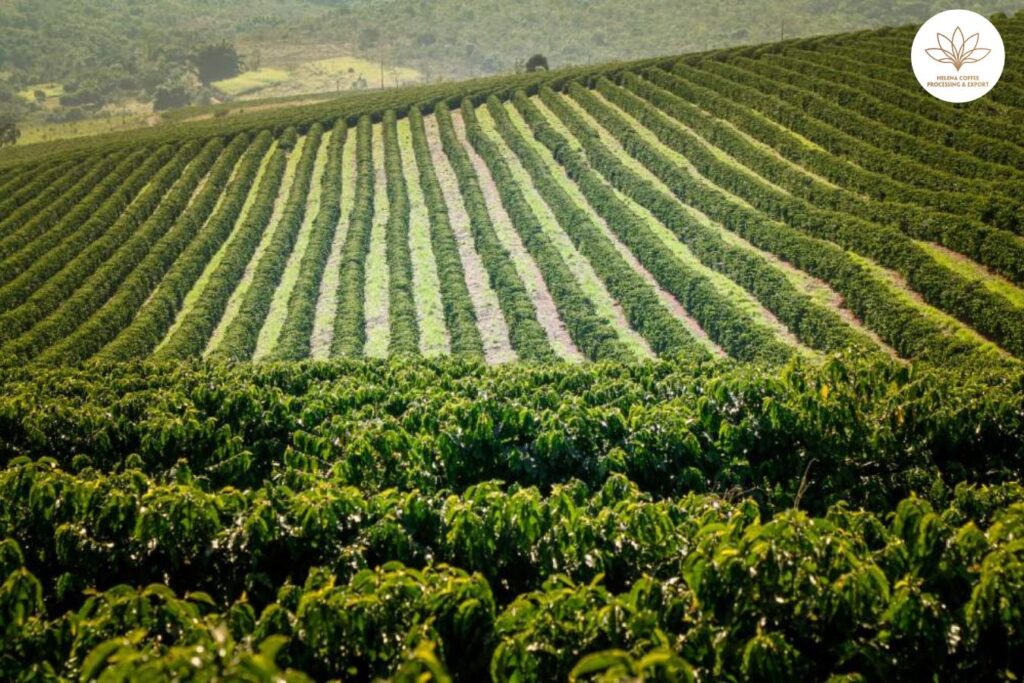Caring for coffee at the beginning of the rainy season: Experiencing the long dry heat wave of the Central Highlands dry season. Entering the rainy season is also the time when coffee berries begin to rapidly increase in size, accompanied by rapid growth of buds, so taking care of nutritional supplements for coffee trees at the beginning of the rainy season is very important. contributes to providing adequate nutrients and creating a healthy growing branch framework for the next crops. According to research by scientists, the development process of coffee plants is divided into many stages, of which the stage of young fruit development is one of the most important stages. At this stage, coffee berries need a higher amount of nutrients. At this time, pests, especially fungal diseases, attack the most, so taking care of coffee at the beginning of the rainy season is extremely important to minimize Coffee berry drop phenomenon.
1. Water Management for Healthy Coffee Plants
According to the recommendations of scientists, to adapt to the current climate situation, agricultural workers and especially coffee growers need to proactively regulate irrigation water sources to avoid excess water. Wasting water or lack of water leads to withered and exhausted coffee plants.
Because the dry season in the Central Highlands lasts 6 months and is quite harsh, it will cause coffee trees to lose their leaves and become infected with some diseases such as rust, crab eye spot, etc. Therefore, entering the rainy season, timely nutritional supplementation is very important to help coffee trees quickly recover and nourish young fruits.
2. Strategic Fertilization Practices for Optimal Coffee Growth
In order to help coffee trees have stable yields and good quality right from the beginning of the rainy season, people need to pay attention to adding fertilizer according to the 4 right principles: right type of fertilizer, right dosage, right method, and right time. Fertilizing at the beginning of the rainy season is very important to create a foundation for coffee to grow in maximum volume for larger beans later. Thus, adding fertilizer in the first batch for the rainy season is very important. At this fertilization, fertilizer with the highest content of nitrogen is required, followed by phosphate and finally potassium.
The amount of fertilizer depends on the specifics of each garden, but the biggest basis is based on coffee yield and the capacity of the garden to respond. The use of single fertilizer or compost depends on the needs of the coffee. However, because people’s way of mixing single fertilizers often does not ensure the nutritional content for coffee plants, scientists recommend that people use compost with balanced nutritional content while still supplementing it appropriately. Managing micronutrients helps the plant absorb well, has a high fruit set rate, and has large and firm fruits, increasing productivity and quality of coffee
3. In summary, when fertilizing and caring for coffee at the beginning of the rainy season, people need to pay attention to the following points
- Prune branches to shape the garden to make it more airy.
- Take timely measures to prevent pests and diseases.
- Add nutrients when you see steady rain, and fertilize when the soil is moist enough.
- You should use compost with complete and balanced nutritional content.
4. For commercial coffee trees, you can fertilize with one of the following types of fertilizers with the following nutritional content
- NPK 18 – 14 – 7 – 13S + TE fertilizer from 550 – 750 kg/ha
- NPK 16 – 16 – 8 – 13S + Boron + Te fertilizer from 500 – 700 kg/ha
- NPK 17 – 14 – 7 – 13S + TE fertilizer from 550 – 750 kg/ha
Note: depending on the yield of the previous crop, farmers can adjust the amount of fertilizer accordingly
Taking care of pruning and shaping branches, airing the garden, taking measures to manage pests and diseases, and adding appropriate nutrition right from the beginning of the rainy season will help coffee growers protect their results. Helps coffee cherries quickly increase in size to accumulate dry matter, increase storage for the next crop, avoid fruit drop , and increase productivity and quality of coffee beans
FAQS:
- Which Coffee Variety Should I Plant? 9 High-Yield Coffee Varieties
- Instructions for Suppliers Of Coffee Roaster Machine For Your Needs
- Learn The Process Of Choosing The Best Organic Coffee Beans

